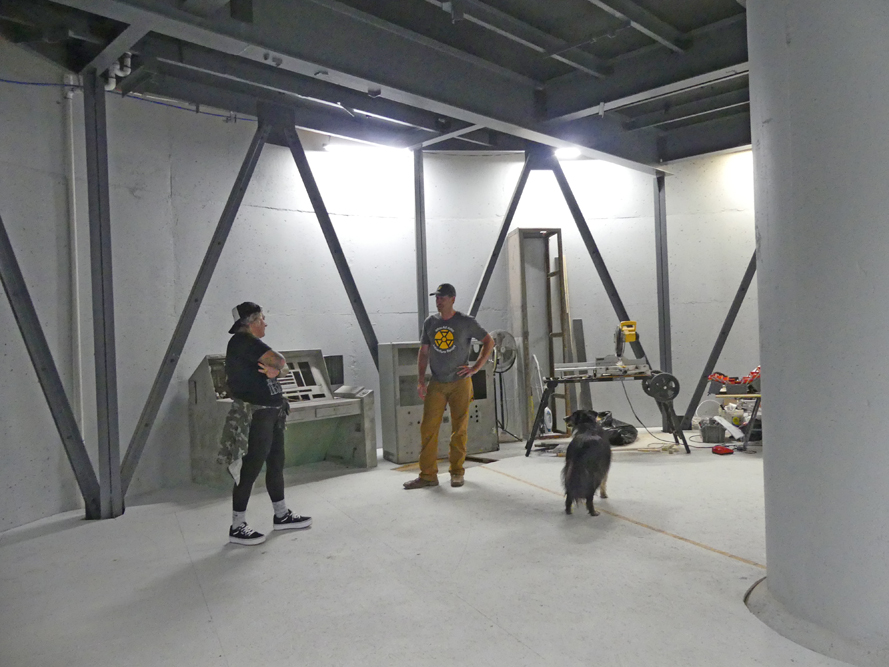Atlas Ad Astra Missile Silo:
The Stuff of Science Fiction
.jpg)
Story and photos
by Kathleen Walls
I remember back in school during the
Cold War years we were told, "Get under your desk when a
nuclear air raid sounds." Yeah, that really would have
protected us from a nuclear bomb! There were science fiction
books and rumors of underground nuclear missile silos built
to retaliate if Russia fired a missile at the US. Later
years proved the rumors were true. Missile silos were built
mostly in western states like Kansas. When the Atlas
missiles became obsolete, the government decommissioned the
missile bases, removed the obsolete missile, and sold the
property. One in Wilson, Kansas was bought by Matthew
Fulkerson.

He has big plans for this silo, which
once housed an Atlas F Missile. He already created an Airbnb
apartment where the military personnel lived, and he can
accommodate a few large RVs, car or van campers who want to
boondock. The countryside is beautiful with a view of a
nearby windfarm. He plans to turn the place into a
full-fledged RV resort with full hook-ups. He has plans for
The Launch Control Center to become an Educational Center
for Space Habitat Studies to prepare humans to live on other
planets.
.jpg)
On the grass above is a large circle
where a steel enforced hatch would have opened to launch the
atlas rocket if an attack was eminent. The hatches are huge
and give an idea of the size of the missile that would pass
through them. Farther over, there is a small cement circular
manhole type entrance with a ladder down it into the heart
of the silo that would have been an emergency exit in case
of any malfunction.

.JPG)
Matthew, along with Buddy and Bing, the
site's resident dogs, led us through the silo. We didn't
enter through the small manhole entrance. We descended into
the silo through some steep stairs. It was like stepping
into an old science fiction book. We passed through multiple
vault type doors about a foot thick called Blast Doors.
.JPG)
The first level down is where Matthew
renovated and created the Airbnb. Inside, the silo is round
and the section where you enter from the staircase is a
large living area. Following around, there is a master
bedroom and a small room with a bunk bed, a bathroom, and a
kitchen. The kitchen area has a curved seating bar
separating it from the living area. Inside here is where the
manhole escape ladder exits to outdoors.
.JPG)
Back in the day, there would have been
a kitchen and toilet here, as well as medical supplies and
the air conditioning and ventilating equipment.
.jpg)
Taking the stairs down to the loser
level, which would have been the Underground Launch Control
Center which would have required two people to activate and
launch the missile to send nuclear destruction raining down
on Russia. It's where Matthew plans to house the Educational
Center.
Directly behind the stairs is the
tunnel leading to the actual silo. One of the most thrilling
parts is walking through that narrow tunnel to stare down
into the actual missile location. Looking up was the reverse
of the cement pad we saw above ground with the hatches to
lauch the missille.
.JPG)
When I staring down, I was looking into
one of the most hardened places man has ever built, to a
depth of about 176 feet and 52 feet wide. The silo,
constructed of reinforced concrete, once stored a nuclear
missile about 82-1/2 feet long and 10 feet in diameter. Had
it ever been activated, the explosion would have been more
powerful than the bombs we dropped on Japan to end WWII.
.JPG)
Public Disclosure Please Read
FTC has a law
requiring web sites to let their readers know if any of the
stories are "sponsored" or compensated. We also are to
let readers know if any of our links are ads. Most are not.
They are just a way to direct you to more information
about the article where the link is placed. We have several ads
on our pages. They are clearly marked as ads. I think
readers are smart enough to know an ad when they see one but to
obey the letter of the law, I am putting this statement here to
make sure everyone understands. American Roads and Global
Highways may contain affiliate links or ads. Further, as their
bios show, most of the feature writers are professional travel
writers. As such we are frequently invited on press trips, also
called fam trips. On these trips most of our lodging, dining,
admissions fees and often plane fare are covered by the city or
firm hosting the trip. It is an opportunity to visit places we
might not otherwise be able to visit. However, no one tells us
what to write about those places. All opinions are 100% those
of the author of that feature column.



